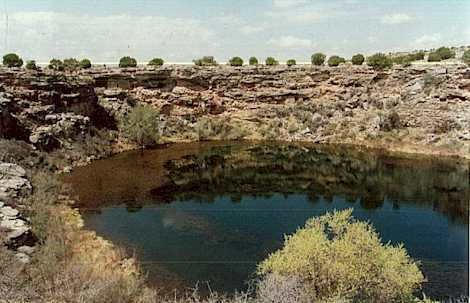
本報告はマンハッタン・ビーチ在住のロンが作成したものである。
The Indians had quite a well established civilization in northern Az - before the European settlers and their diseases wiped most of them out (see Guns, Germs...) (English Library Serial No.432). Most often they built their dwellings under the shelter of natural cliffs and overhangs. They had developed agriculture and many of their settlements had hundreds of inhabitants.
The first three pictures are at a location known as Montezuma's well. This had nothing to do with the actual Montezuma, who lived thousands of miles south of here. Just a slightly whimsical humorous name. This "well" was in fact a limestone cave with the roof weathered away, leaving a bowl-shaped depression. A hot spring keeps the bottom of the depression filled with water. In the first picture you can get some idea of the blue-green color of the pond and can see the algae floating on the surface to the left side. The pond level is maintained by an outlet at water level through a crack in the wall. The Indians used this water stream, which flows winter and summer, to irrigate fields outside the well area. You can just see some of their dwellings just below the rim, upper left.

モンテズマの泉
Next picture shows these dwellings in more detail. In the foreground is a plaque describing the formation of the "well". You can just make out the general shape of the geological formation.
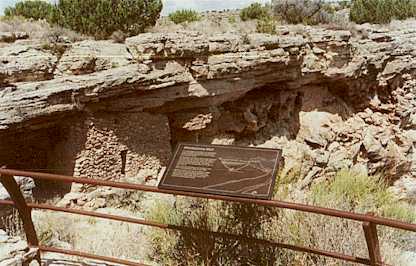
モンテズマの泉居住地のクローズアップ
Other dwellings were lower down, near the water level. One of them, built in a natural cave is shown in the next photo The dark hole on the right goes as far as its possible to see from the outside. The blackening of the roof is caused by cooking fires over the centuries.
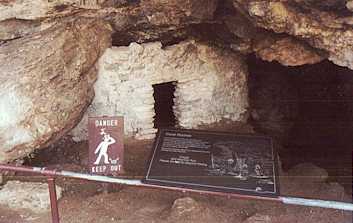
水面近くの居住地
Another location has a much more ambitious building, also whimsically named "Montezuma's Castle". It was built in stages over many years, adding "floors" and rooms as they went along. The actual structure was restored in modern times. The guides assured us that it is a faithful reproduction. Access to all these buildings was through ladders which were propped up from the valley floor where I stood to take the picture.
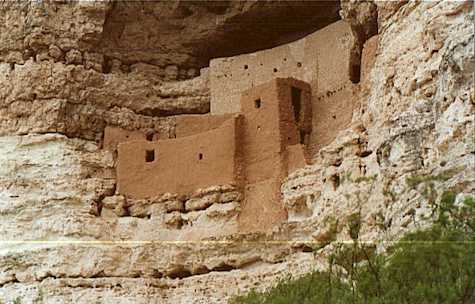
モンテズマの要塞
Yet another location is known as "Tuzigoot". This was a very large settlement. The many room were strung out along a ridge. Its believed that about 400 people lived here. This ruin, too, has been restored (in the 1930's as a WPA project). The authentic mud used for the restoration requires constant repair after rain falls - not a very satisfactory building material! The triangular orange area to the right edge is part of a very large dumping ground for tailings from copper extraction in local mines. The area is, of course, quite dead. Luckily it doesn't impinge on the Indian site.
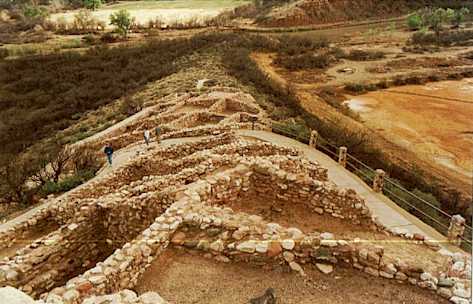
ツジゴート遺跡
Next photo shows a reproduction of the interior of a Tuzigoot house. The only access is through the hole in the roof - for protection from animals and, perhaps, other Indians. This hole also lets out the smoke from the cooking fire.
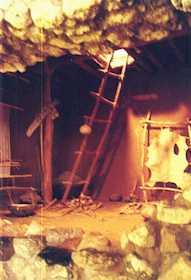
ツジゴート遺跡の家の内部
以上はクーパー氏の報告であるがJared DiamondのGuns, Germs, and Steel(Library432)を取材したTV番組をみているとアナサジ・インディアンが12世紀ころ忽然と姿を消したのは周辺の森林を伐採した植生が再生しなかったためとの説が印象ふかかった。ツジゴート遺跡もその一つなのだろう。ちょうどイースター島で発生したこととおなじことが生じたのである。日本は世界の森林を食いつぶしている。この木材の浪費をとめないと世界に災いをもたらすだろう。
February 26, 2011